I started making no-knead bread in 2010 and it has continued to be my favorite way to make homemade bread because it’s incredibly simple, it doesn’t require a lot of effort, and it makes the most deliciously crusty bakery-style bread ever. To make this no-knead bread recipe you only need four ingredients (including water) and a little bit of time. No fancy equipment or techniques needed!
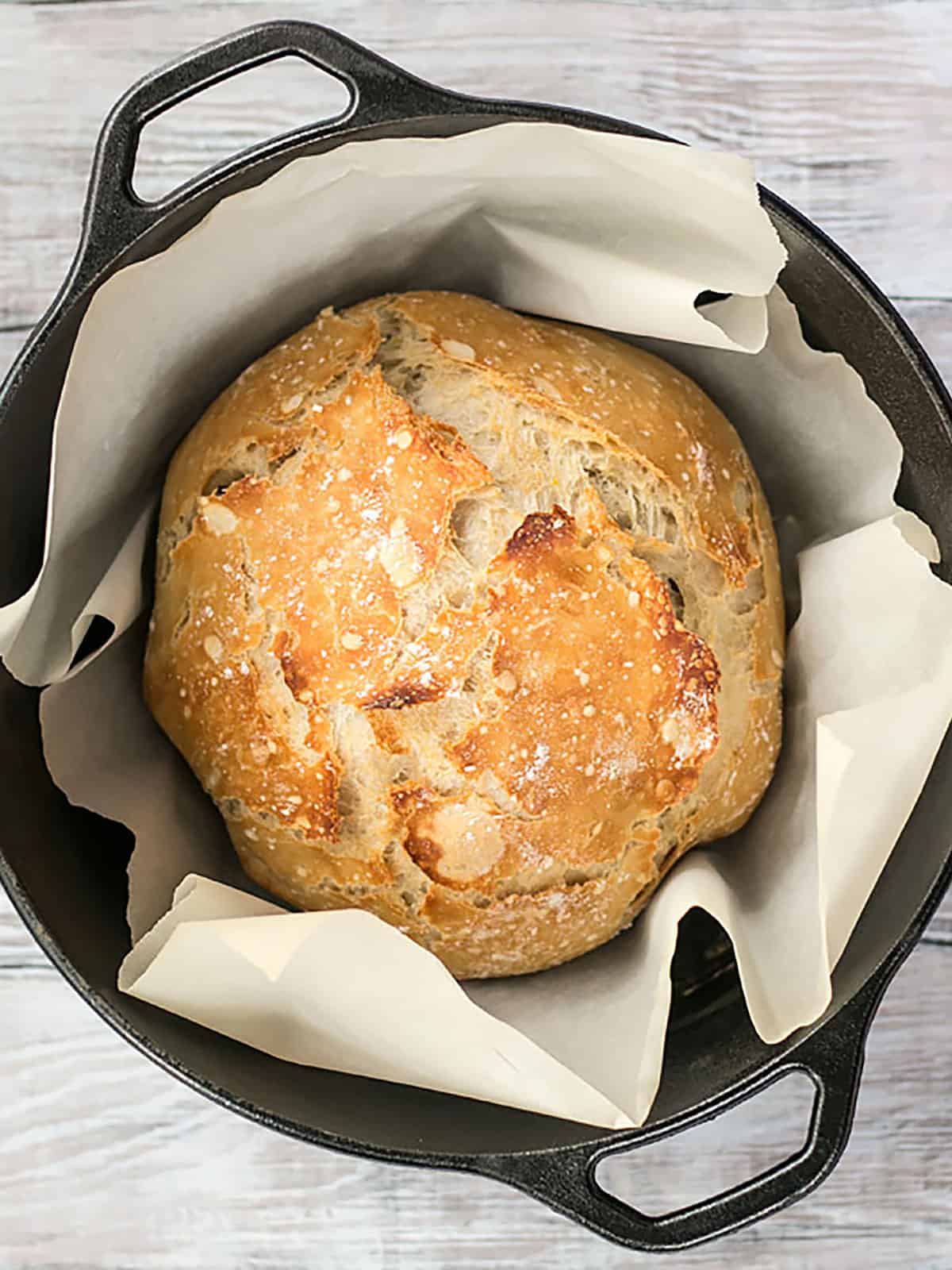
This post contains some affiliate links, which means that we make a small commission off items you purchase at no additional cost to you.
“I’ve made this twice and it was amazing! Hard to believe something so simple can come together to be something so amazing!”
-Melissa
What Is No Knead Bread?
No-knead bread is an ancient technique for making delicious loaves of bread by utilizing a long fermentation time to develop the gluten the flour instead of hand kneading. Gluten is the protein that gives bread its strength, allowing it to rise into a fluffy loaf, and have that deliciously chewy texture. Kneading bread dough develops gluten quickly, but is quite labor-intensive. If given enough time, yeast can develop the gluten in the dough without the need for manual needing.
Ingredients for No Knead Bread
The best part about this no-knead bread recipe is that it only requires four ingredients, including water, and you still get an incredibly flavorful bread. Here’s all you’ll need to make your own homemade no-knead bread:
- Flour: Our version of no-knead bread was developed using all-purpose flour because that is what we most commonly have on hand. That being said, using bread flour will create even better results. Just keep in mind that bread flour tends to absorb more water than all-purpose flour, so you may need to adjust the ratios slightly.
- Yeast: For this type of bread, we use instant yeast or bread machine yeast, both of which do not need to be activated first by proofing in warm water. You can simply add them to your dry ingredients and go!
- Salt: Without the proper amount of salt, homemade bread will have no flavor, so it’s imperative that you do not skip the salt.
- Water: Water hydrates the flour to create the dough. Because this technique uses a longer ferment time, you can use room-temperature water and you do not have to “wake up” the yeast with warm water. The yeast will have plenty of time to activate as it rests.
What Kind of Yeast to Use
It’s very important to use the correct type of yeast for this recipe. Instant yeast and bread machine yeast are special because they do not require mixing with warm water to “wake up” before adding to a recipe. You can simply stir them into the dry ingredients and they will activate instantly upon hydration, so that is what we use for this super simple no-knead bread technique. Active Dry yeast, on the other hand, needs to be specifically activated in warm water first. If you use active dry yeast in this recipe using the technique below, the bread will likely not rise.
Do I Need to Use a Dutch Oven?
Using a preheated Dutch oven does create the best results because it gives the bread an extra intense boost of heat while retaining all of the moisture and steam. That being said, I have made no-knead bread on a sheet pan with great results! I suggest adding a pan with an inch or so of water on the bottom rack of your oven to create steam if you’re baking your bread on a sheet pan.
If possible, I would suggest investing in a Dutch Oven because they are easily one of the most flexible and useful pieces of cookware. We love our Amazon Basics 6-Quart Enameled Dutch Oven as a very affordable alternative to Le Creuset. Lodge also makes very affordable Enameled Dutch Ovens and plain Cast Iron Dutch Ovens (like the one used in the photos here).
Short Fermentation vs. Long Fermentation
You can make no-knead bread using either a long fermentation (12-18 hours) or a short fermentation (about 2 hours). The difference is that you’ll need more yeast to do the short fermentation and the flavor does not develop quite as deeply. That being said, short fermentation no-knead bread is a great option when you haven’t planned ahead!
Long Fermenation: Follow the instructions below, using ¼ tsp yeast and fermenting the dough for 12-18 hours.
Short Fermentation: Use 2 tsp yeast (or one ¼ oz. packet) and ferment the dough for about 2 hours at room temperature.
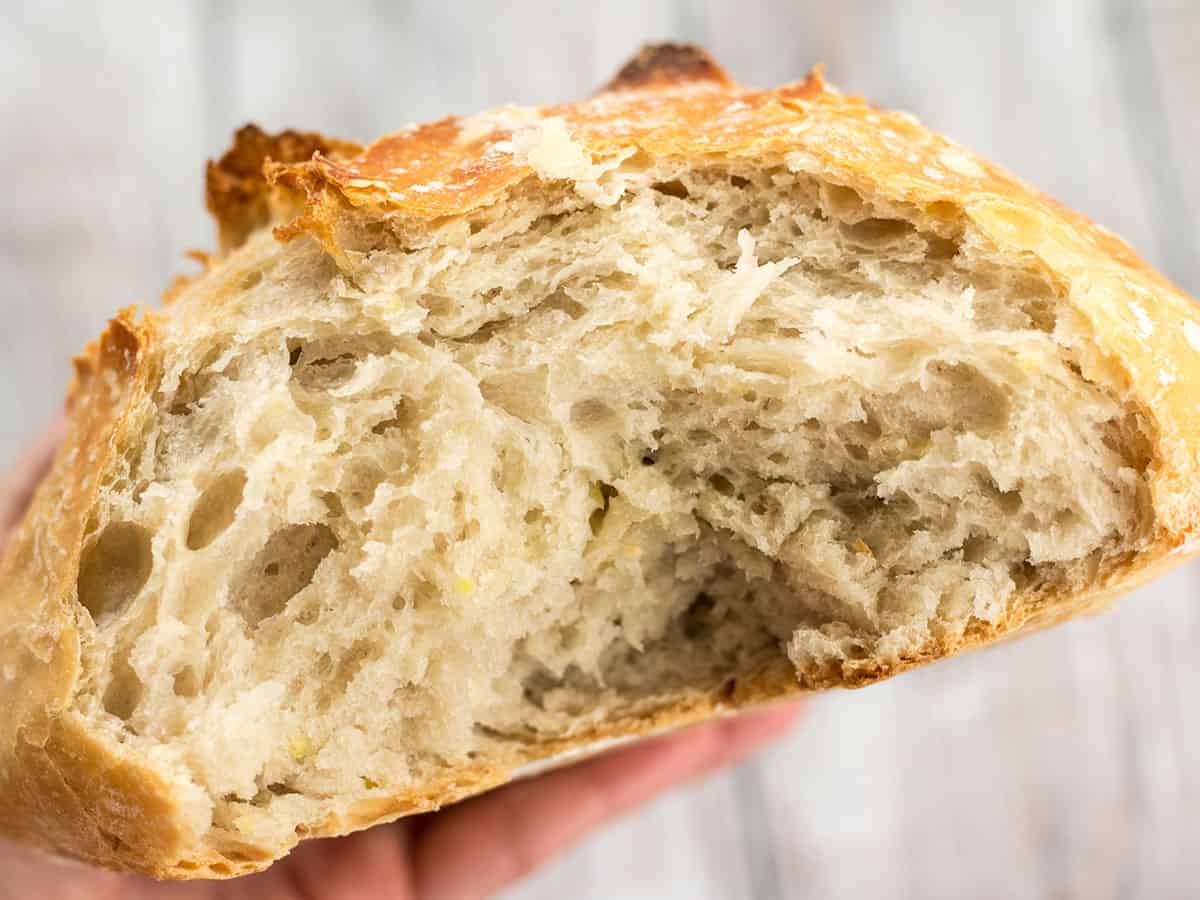
No-Knead Bread
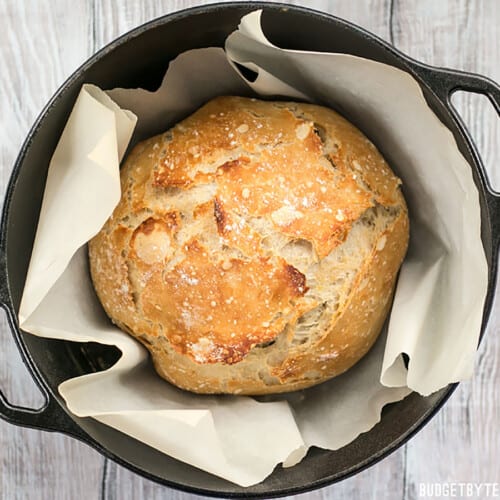
Ingredients
- 3 cups all-purpose flour ($0.29)
- 1/4 tsp instant yeast or bread machine yeast* ($0.02)
- 1.5 tsp salt ($0.02)
- 1.5 to 1.75 cup water** ($0.00)
Instructions
- The day before baking, combine the flour, yeast, and salt in a large bowl and stir until they're well combined. Stir in about 1.5 to 1.75 cups room temperature water until a shaggy, sticky ball of dough forms and there is no dry flour left on the bottom of the bowl. The dough should be wet and sticky, but not so wet that it appears glossy. Cover the bowl loosely with plastic and let it sit at room temperature for 12-18 hours.
- The next day, the dough should be fluffy and very bubbly. When you're ready to bake, sprinkle a little flour on top of the fermented dough and scrape it out of the bowl. With well-floured hands, shape the dough into a ball and place it on a piece of parchment paper. Let the dough rise for 30-60 minutes.
- While the dough is rising, preheat the oven to 425ºF, or the highest recommended temperature listed on the packaging for your parchment paper. Place the Dutch oven inside the oven as it preheats, and make sure it sits in the fully heated oven for at least 15 minutes before baking the bread.
- Once the bread has risen and the Dutch oven is fully heated, carefully remove the Dutch oven from the oven (it will be EXTREMELY hot). Lift the parchment with the dough straight into the dutch oven and cover it with the lid.
- Return the Dutch oven to the oven and bake for 30 minutes. Carefully remove the lid and bake for another 15-20 minutes, or until the crust is a deep golden brown. Remove the Dutch oven from the oven, lift the bread out by by using the parchment paper, and allow it to cool before cutting open and serving.
Sheet Pan Instructions
- Ferment and shape the dough as described above, then place it on a parchment-lined sheet pan to rise for an additional 30 minutes.
- Place a baking pan with about an inch of water on the bottom rack of the oven, then preheat to 425ºF while the dough rises.
- Once the loaf has risen for 30 minutes and the oven is fully preheated, carefully score the top of the dough with a sharp knife (use horizontal motions with no downward pressure). Transfer the sheet pan to the oven and bake for 40 minutes, or until the crust is deeply golden brown and the loaf sounds hollow when tapped.
See how we calculate recipe costs here.
Equipment
- Cast Iron Dutch Oven
- Mixing Bowls
- Parchment Paper
- Liquid Measuring Cup
Notes
Nutrition
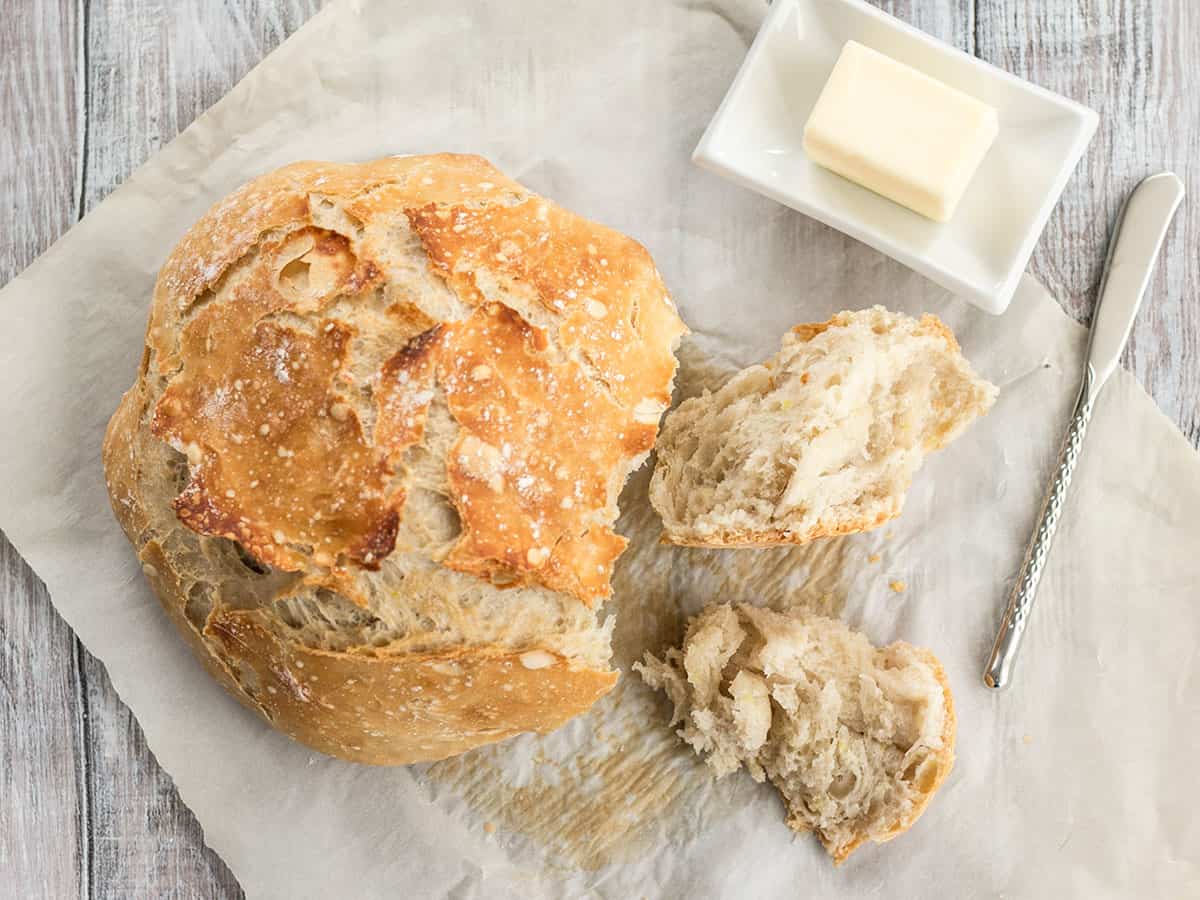
How to Make No-Knead Bread – Step by Step Photos
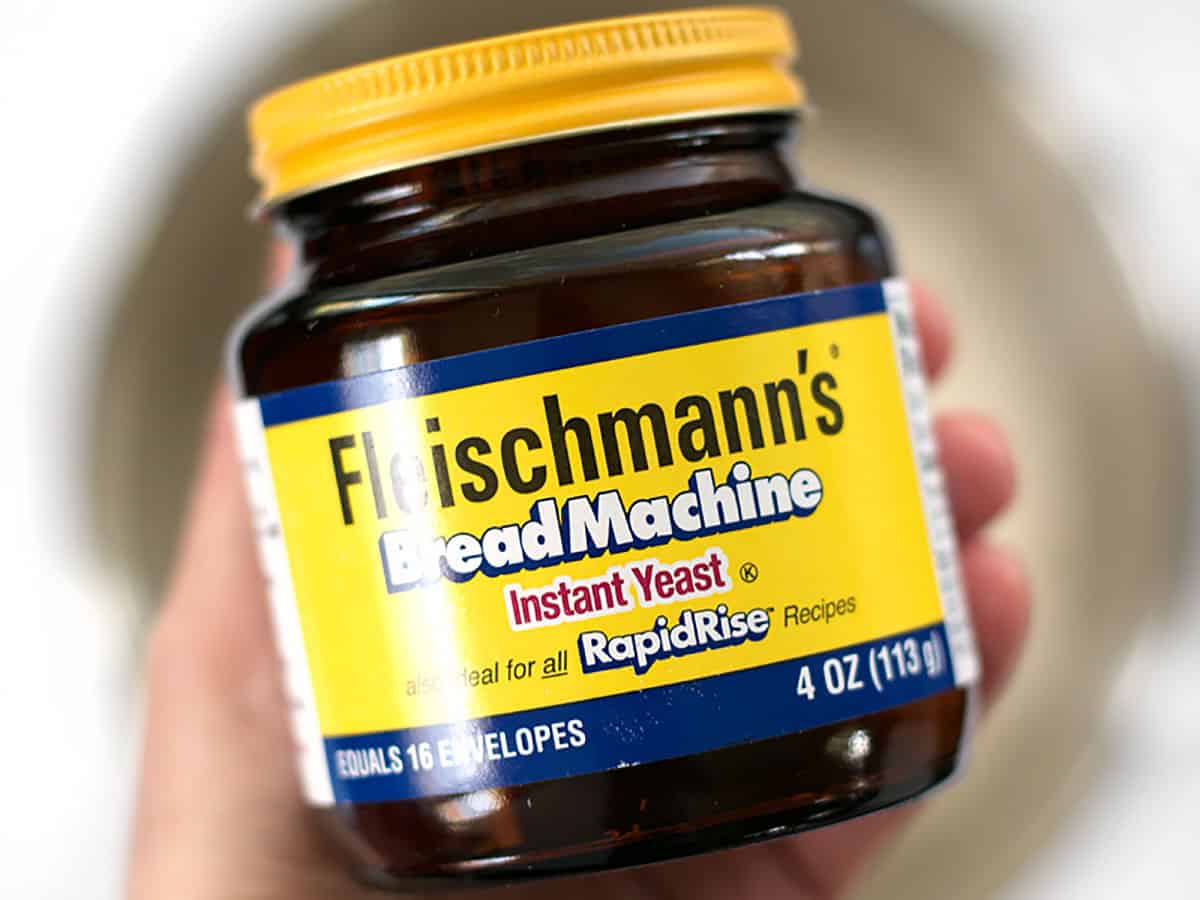
Before you begin, make sure you have “instant yeast” or “bread machine yeast” rather than “active dry”. The reason you need this type of yeast specifically is because it does not need to be kick-started by mixing with warm water first. You can add it to a recipe dry and it will still activate. I buy these little jars, which I keep in my fridge, and they last for-ev-er (especially when you’re only using 1/4 tsp at a time)!
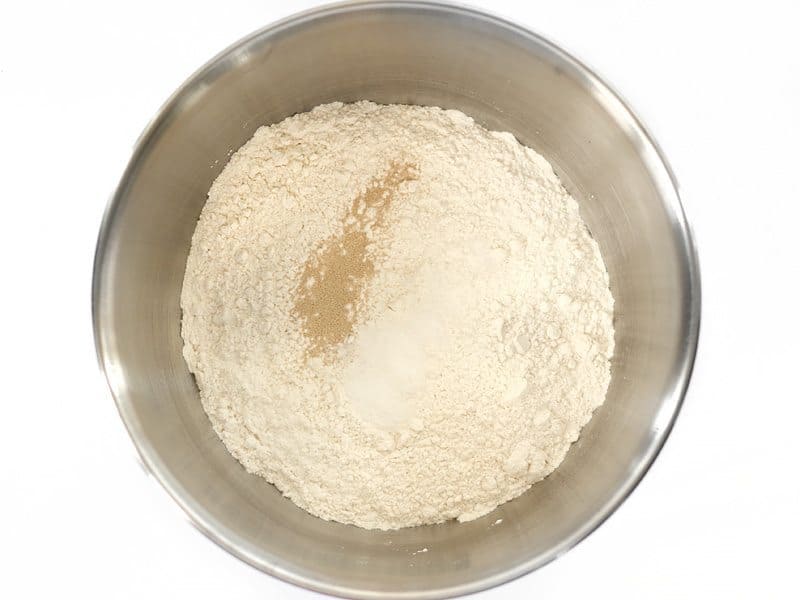
The day before you want to actually bake the bread, combine 3 cups all-purpose flour, 1/4 tsp instant or bread machine yeast, and 1/2 Tbsp salt in a large bowl. Stir them together really well.
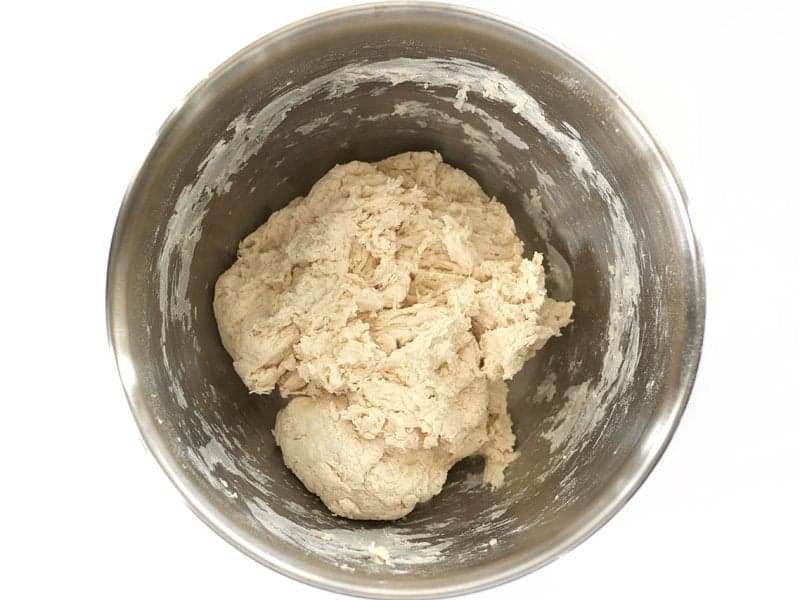
Stir in about 1.5 to 1.75 cups of room temperature water, or just enough to form a shaggy ball of slightly sticky dough, and no dry flour is left on the bottom of the bowl. The total amount of water needed may vary from time to time depending on the ambient humidity and moisture content of the flour, so go on visuals here. Make sure it comes together in one ball and no dry flour is left on the bottom of the bowl. It’s okay for it to be a bit sticky.
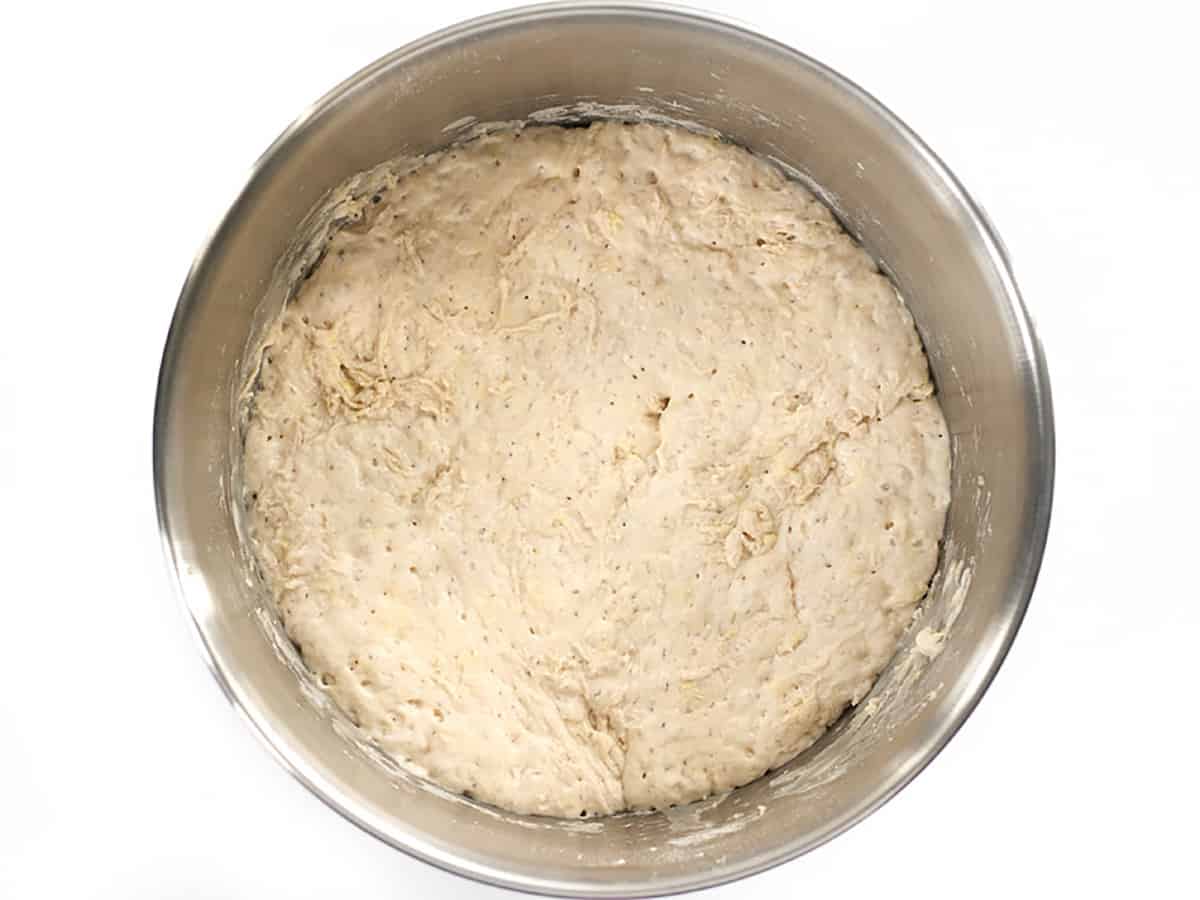
Loosely cover the bowl with plastic and let the dough ferment at room temperature for 12-18 hours. If you need to let it sit longer than that to fit your schedule, just transfer it to the refrigerator. As the dough ferments, it becomes very big, light, fluffy, and bubbly.
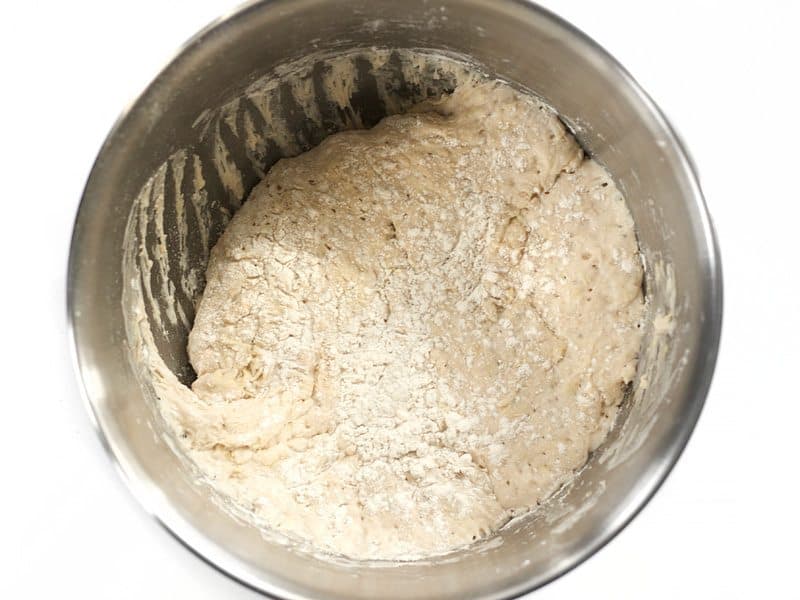
Sprinkle a little flour onto the dough (because it will be sticky) and scrape it out of the bowl. It will begin to deflate as you scrape it out.
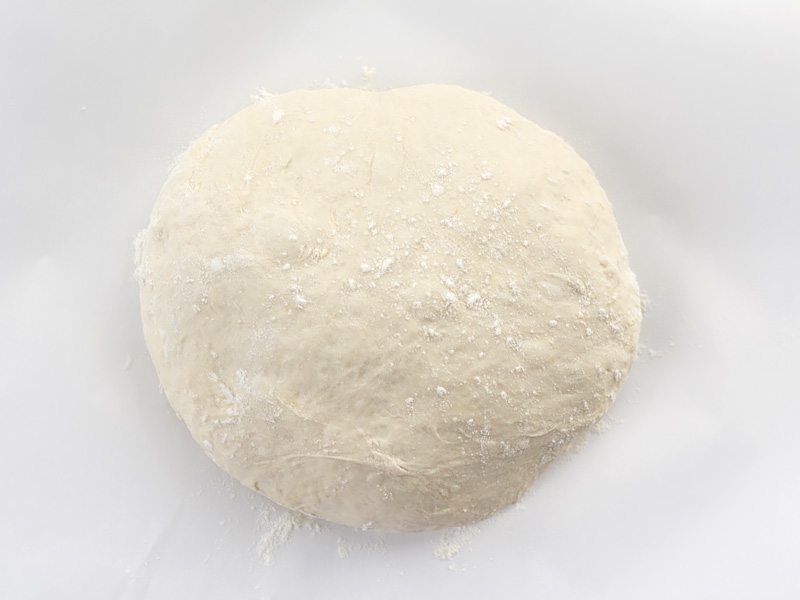
Using floured hands, shape the dough into a ball, then place it on a large piece of parchment. Let the dough rise for 30-60 minutes. The shorter rise time will produce a slightly more dense bread and the longer rise time will have larger bubbles.
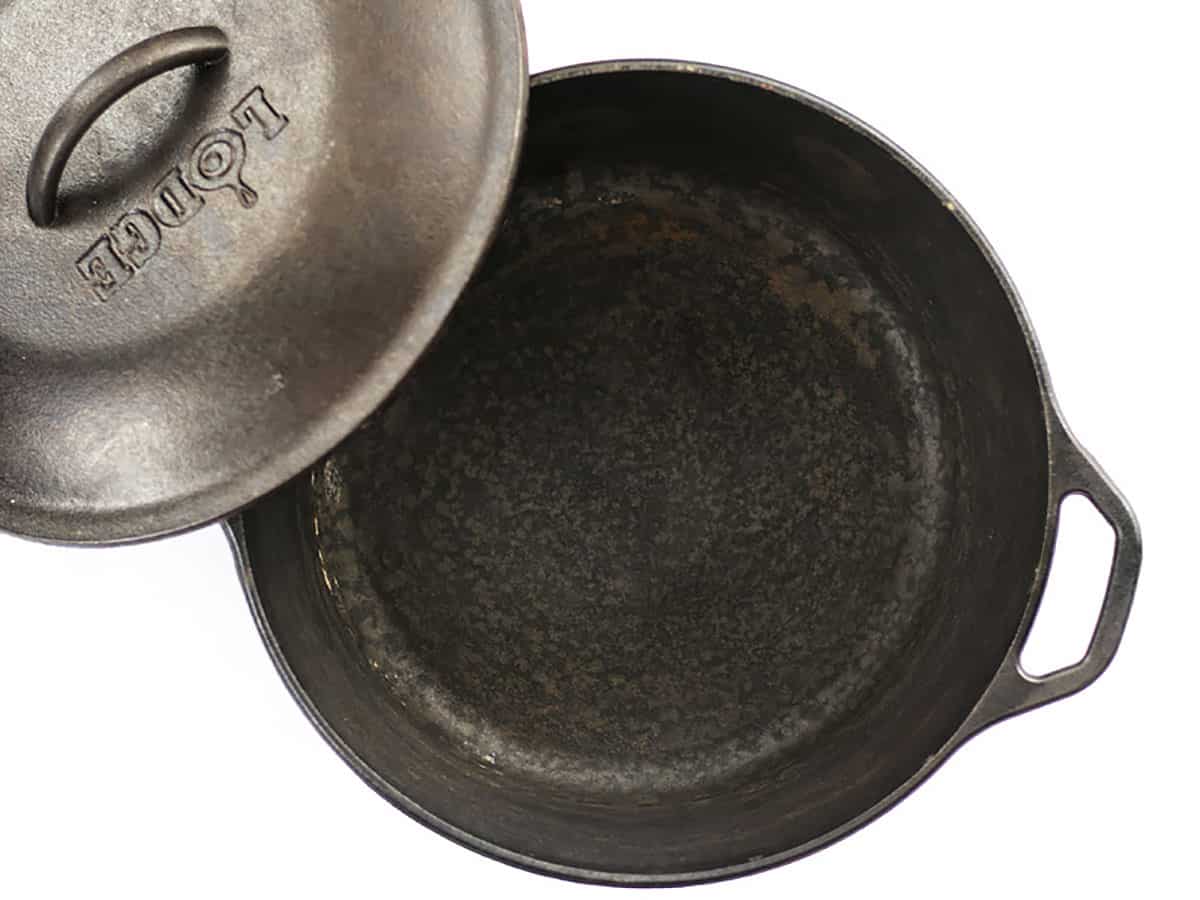
While the dough is rising, begin to preheat the oven and the Dutch oven. Set the oven to 425ºF, or whatever the highest safest temperature is for your brand of parchment (it will usually be listed on the box somewhere). Make sure your Dutch oven is inside the oven as it preheats, and then let it heat for an additional 15 minutes or so once the oven is up to temperature. This makes sure that the Dutch oven is nice and hot.
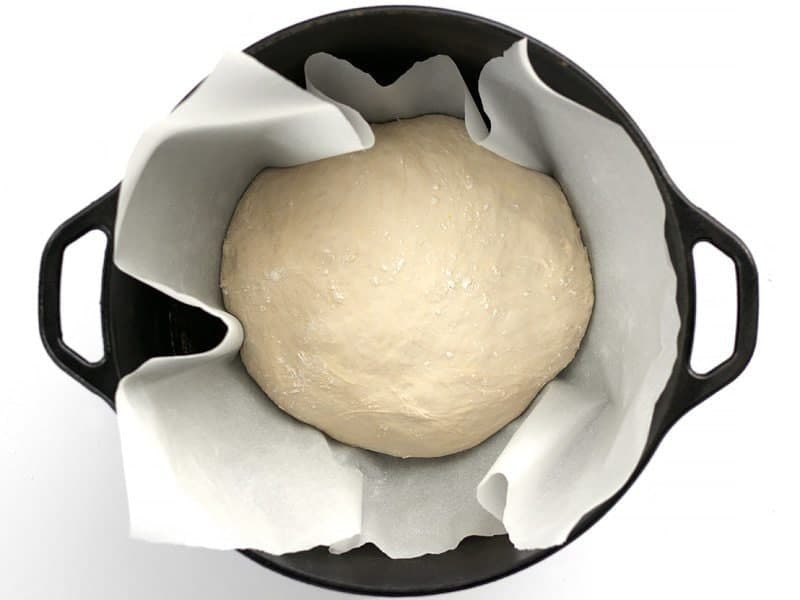
When the dough is risen and the Dutch oven is fully preheated, carefully remove the Dutch oven from the oven (it will be extremely hot!). Lift the risen dough by the parchment and place it inside the Dutch oven, parchment and all. Place the lid on the Dutch oven and return it to the hot oven.
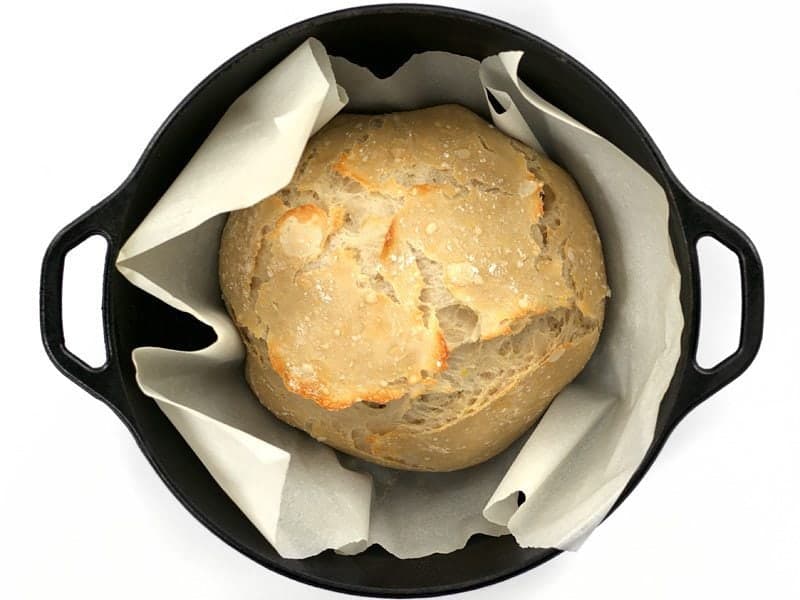
Let it bake for 30 minutes with the lid on the Dutch Oven, then carefully remove the lid…
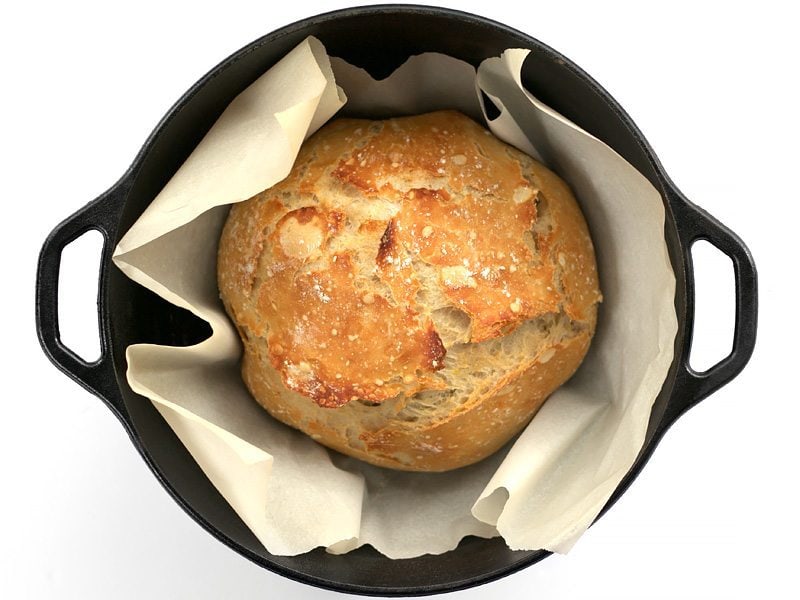
Then bake it for an additional 15 minutes or so WITHOUT the lid to allow the crust to brown.
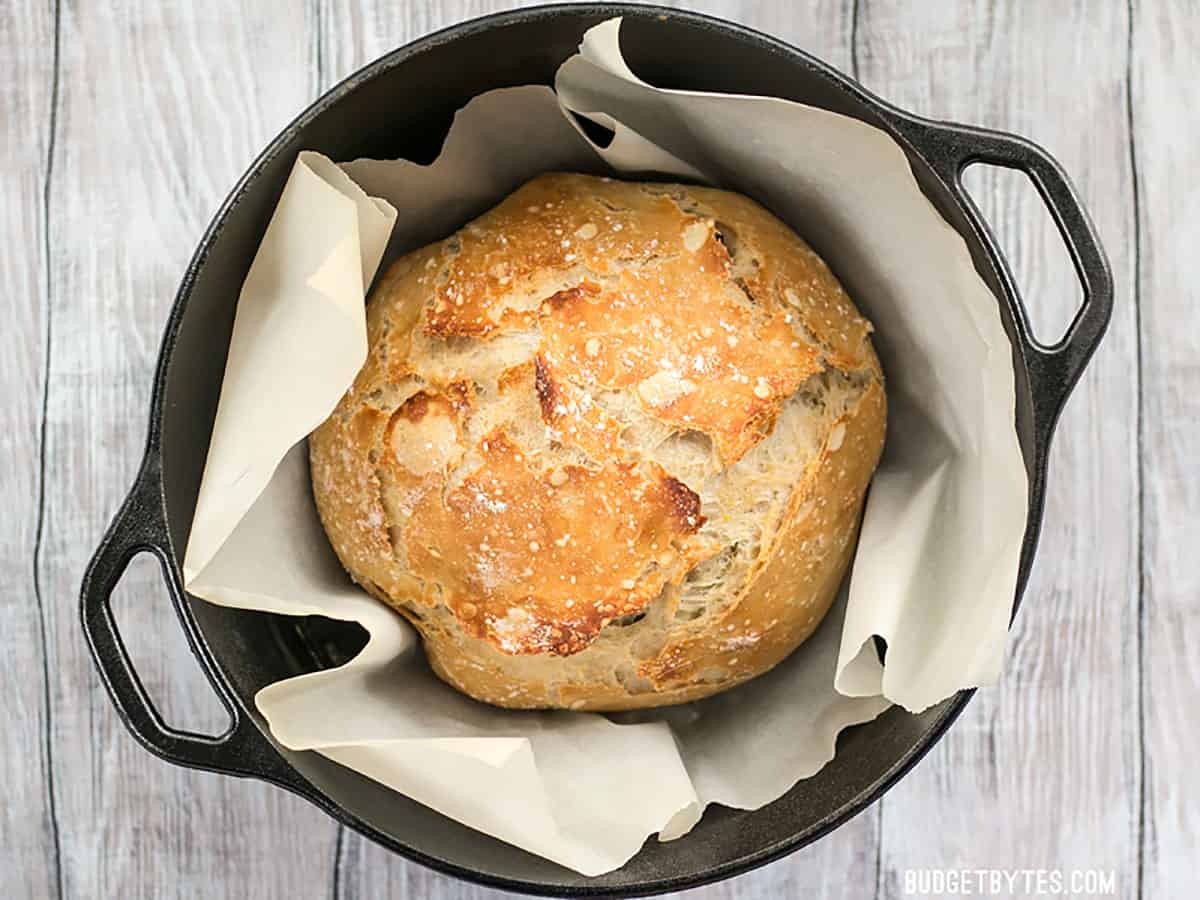
Once the crust achieves a nice deep golden brown color, carefully remove the Dutch Oven from the oven. Lift the no-knead bread out of the Dutch oven by the parchment, and allow it to cool before serving.
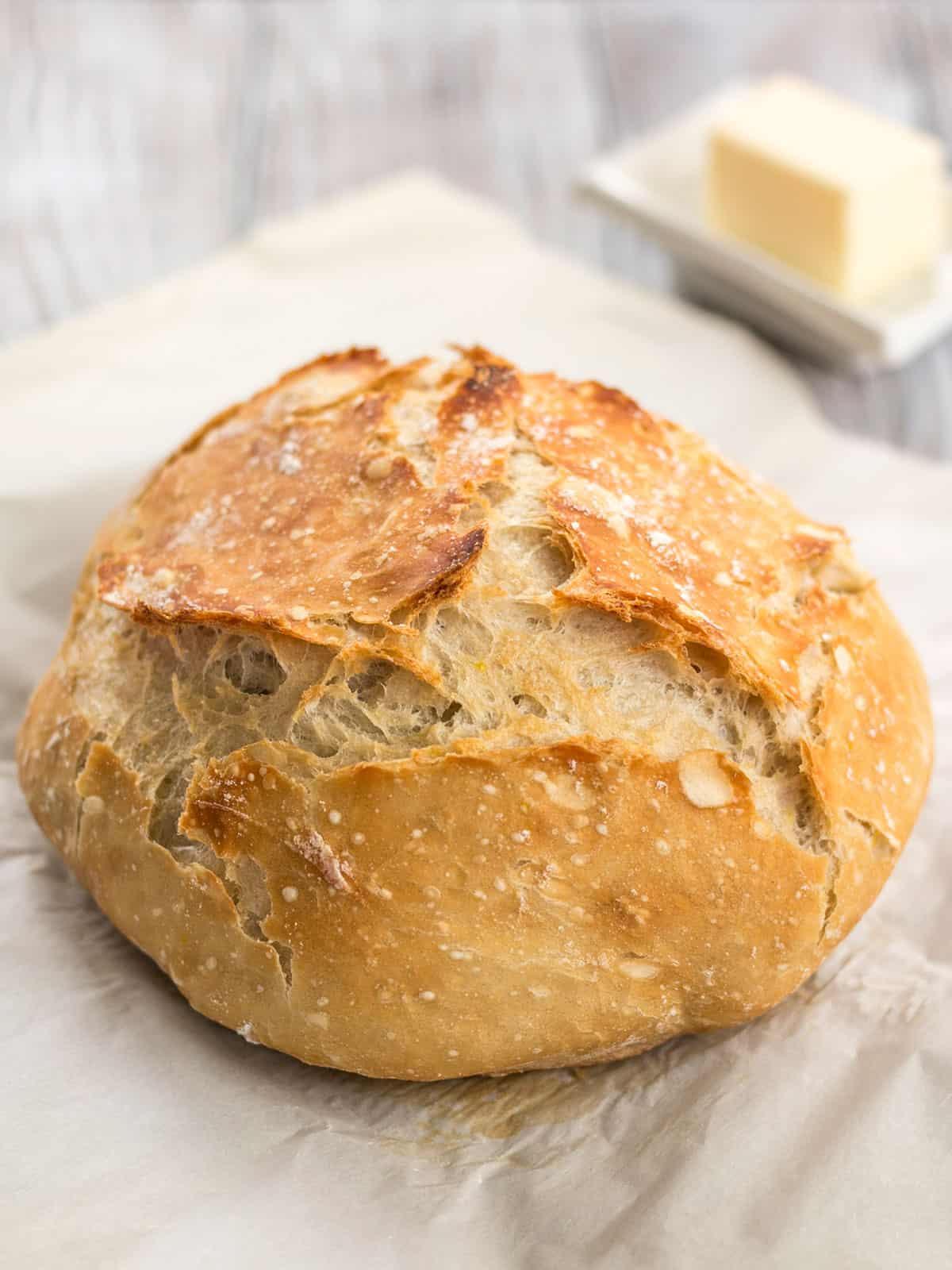
And just be prepared for the BEST bread you’ve ever made yourself. ;) The crust on this no-knead bread is seriously amazing.
No Dutch Oven and Short Fermentation Instructions
So, as I mentioned before, you can still bake this bread without a Dutch oven and with a short, 2-hour fermentation time. Here is a photo of my no-knead bread using just 2 hours of fermentation (plus another 1 hr rise time) and baked on a baking sheet.
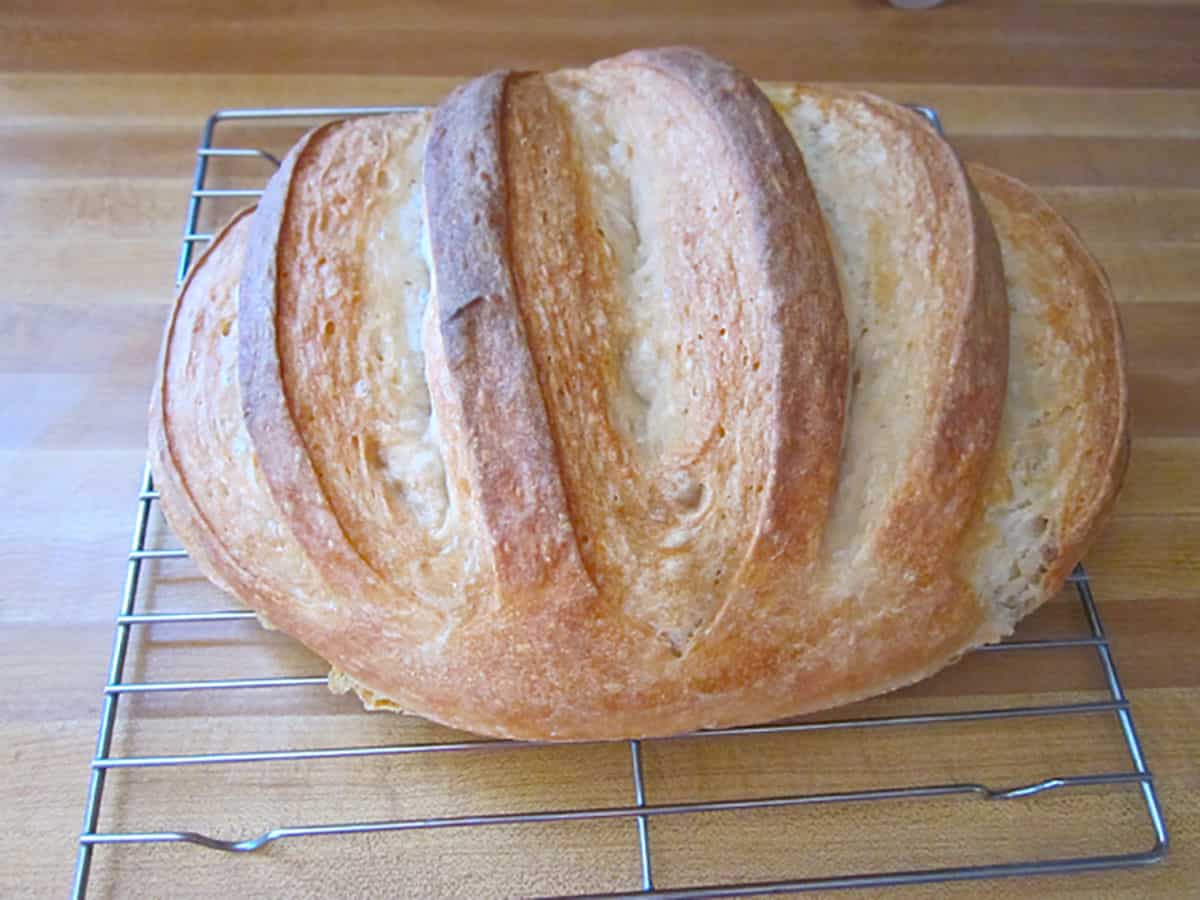
If you only have about 2-3 hours to ferment the dough, you’ll need to increase the amount of yeast used to 2 tsp (instead of 1/4 tsp).
Let the dough ferment in the bowl for 2 hours, then shape it into a loaf, transfer it to a baking sheet covered with parchment (and sprinkled with cornmeal, if desired) and let rise for about another hour. I like to make slits in the top with a sharp knife after the loaf has risen. Be careful though, if the knife is not sharp enough or you use too much downward pressure, it can deflate the dough.
Brush the surface of the dough with water, then bake it in a preheated oven (again, as hot as the parchment will allow, usually around 425ºF) for 30-40 minutes, or until the crust is nicely browned.


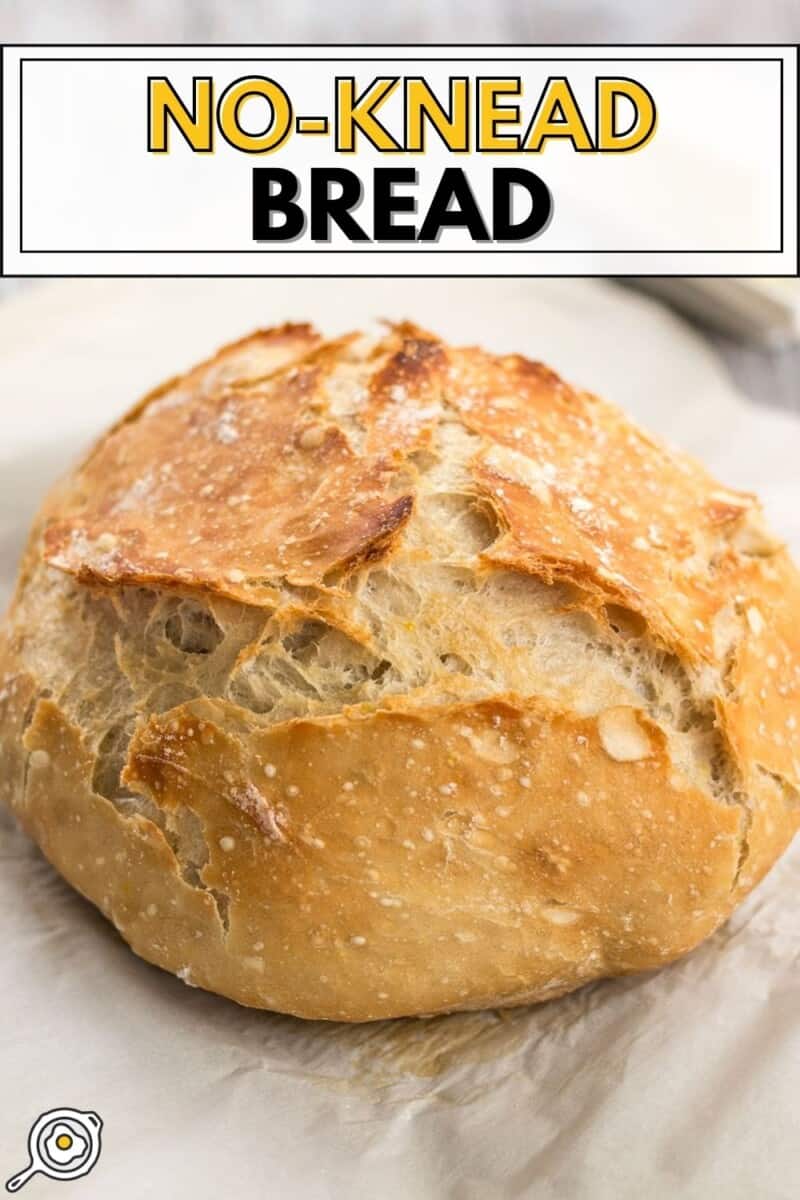
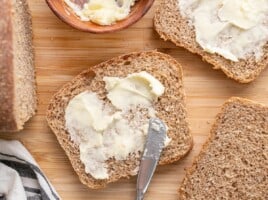
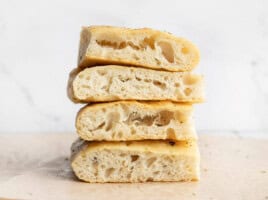
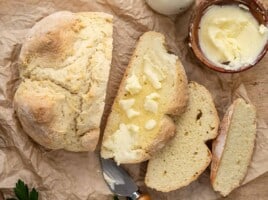
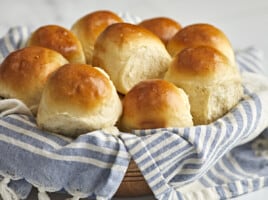
Holy cow this is so good!! Already made it twice in the past week or so. Now I’m excited to try all sorts of different breads. From all my bread-making-challenged friends and me, thank you!!
Have you tried adding flax seed or sunflower seeds, etc to try to add some nutrition. Thanks!
I have a Seeded No-Knead Bread recipe that has chia, hemp, and flaxseeds. It’s so good! :)
Let me start off by saying I love your blog! Is there a video of this somewhere bc something went horribly wrong and based on the reviews it must be me. No matter how much flour I used I ended up with an awfully sticky dough that was not even remotely close to being able to be formed into a ball. Half of it ran through my fingers and another 1/4 I managed to scape off my counter and plop it down into a blob on some parchment. I need bread making for dummies or something 🤦♀️
Hmm, I don’t have a video of this particular recipe, but my No-Knead Focaccia Rolls are pretty much the same dough, and there is a video of that one. The dough should be sticky, but not so loose that it falls between your fingers.
To make this sourdough bread, can you use buttermilk instead of water ? If so, how much milk? Should milk be room temp?
P.S. you mentioned sprinkling the top with water to soften the crust does this also apply to the bottom crust?
Thanks
Unfortunately I’ve never experimented with sour dough or using buttermilk, so I can’t offer any recommendations there. Yes, if you wanted the bottom a bit softer, you could brush a little water there as well.
If I don’t have parchment paper, can I just put some oil in the Dutch oven so it doesn’t stick?
Can’t really wait to try this! Have you used whole wheat flour before? Trying to up the nutrition/fiber!
Mariela
The only problem you’ll have is that you won’t be able to lift the risen loaf into the hot Dutch oven. The loaf is very delicate when it’s not baked. :)
Have you ever used whole wheat flour?
I’ve used up to 1/2 whole wheat flour and it works great, but you may need slightly more water. :)
Any chance you have tried this as gluten free with a gluten free flour? I’d love to find an easy bread recipe!
Thanks!
Unfortunately I haven’t tried that, but I do know that the gluten in the flour is critical to creating the texture in this bread, so I’m guessing it wouldn’t work so well.
Can you use whole wheat flour? We don’t use white flour for much at all. Thanks!
I wouldn’t suggest using more than 50% whole wheat flour because at that point it starts to affect the texture and density too much. You may need slightly more water if using some whole wheat flour as well, since whole wheat flour absorbs more than white flour.
Hi Beth any tipps how i can avoid the crust becoming to crunchy and the bottom to hard, the inside turned out very well but the bottom is tooth shattering hard. I baked it for 30 min in the dutch oven and 15 minutes without lid, at 220 degrees Celsius. Was that too long or to hot?
You can try brushing the crust with a little water before you bake, that should help keep it a bit softer.
Can I bake this in a cast iron skillet with no lid? I don’t have a Dutch oven.
Yes, but it won’t produce as nice of a crust. The Dutch oven holds in the steam, which makes a really nice crust.
Thanks! I have remade this bread a bunch now. It is so awesome and so easy! I ended up using my cast-iron skillet and covered it with my other cast-iron skillet (of the same size) as a lid. I’m pretty sure it worked just like a Dutch oven because the crust turned out just like your pictures! I love the crunchy crust so much! My husband likes it a little softer so I take it out after that first initial 30 minutes of covered baking time when I make it for him. The crust is a little less crunchy but the bread inside is still done and baked nicely.
I make this a lot as written, but recently I made a rosemary-garlic version that tasted AMAZING. I added 2 Tbsp olive oil, 4 minced garlic cloves, 1 Tbsp dried rosemary, 0.5 tsp oregano, and 0.25 tsp black pepper. Then, right before it went in the oven, I coated the loaf with more olive oil and sprinkled it with extra rosemary. So, so good! (If you crush the dried rosemary in a mortar and pestle before adding it in, it helps release the flavor.)
Love it! Thanks for sharing!
Hi , I really want to make this . Can I use bread flour ? Thanks !
Yes, I’m sure that would work, although you may need to adjust the liquid amount as that type of flour might absorb a little more or less water than AP flour.
This turned out so good! Pretty sure this is going to be my regular go-to bed baking recipe.
Hello,
Regarding the No-Knead bread recipe: All I have on hand is active yeast. Can I use the active yeast as long as I use warm water? If so, how much do I use? Same amount of fermentation time?
Thanks!
Yes, you would need to activate it in warm water first. The warm water will change the fermentation time, but unfortunately it’s hard for me to estimate without having tested it.
The first time I made no-knead bread, I used active yeast, activated it first in a little bit of warm water, and just used a little less room temperature water. let it rise/sit for 15 hours, or around that. It was great!
The recipe notes that you can move the dough to the refrigerator if you aren’t going to bake it after the fermentation time is up. Does that mean that I should put in the fridge after the fermentation period is up OR let it do the fermentation thing slowly in the fridge . . . I’m thinking option 1 :D
Also, when I take it out of the fridge, do I need to let it come to room temp before proceeding?
Thanks!
You can do either, but depending on how long you need to wait to bake it, it might be a better idea to just let it ferment in the fridge the whole time. If it’s just a matter of a couple hours, you can put it in the fridge after fermentation. You can just let it sit out at room temperature for a half hour or so to let it come back up to room temp. :)
Thanks for the quick response!! I’m making today, baking tomorrow, so I’ll let it ferment in the fridge!